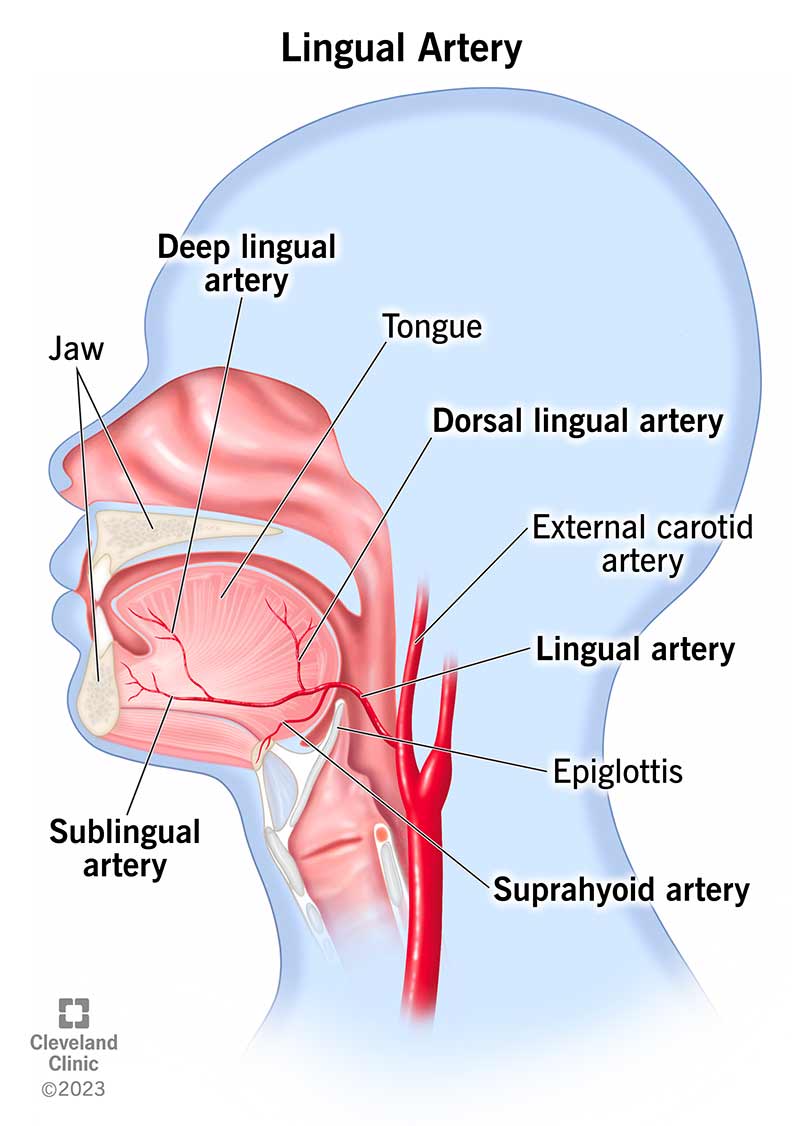Your lingual artery takes blood from your carotid artery in your neck to parts of your mouth. It runs under your jaw and ends at the tip of your tongue. Four branches of your lingual artery carry blood to specific areas in your mouth, including your tongue and several muscles.
Advertisement
Cleveland Clinic is a non-profit academic medical center. Advertising on our site helps support our mission. We do not endorse non-Cleveland Clinic products or services. Policy

Your lingual artery is a blood vessel that brings blood from your neck to several parts of your mouth. You have one lingual artery on either side of your jaw. This blood supply is important to the muscles and tissues you use when you eat or talk.
Advertisement
Cleveland Clinic is a non-profit academic medical center. Advertising on our site helps support our mission. We do not endorse non-Cleveland Clinic products or services. Policy
The lingual artery supplies blood to parts of your mouth. These include your:
Your lingual artery branches off from your external carotid artery, which runs up and down your neck. Starting in your neck, your lingual artery goes forward and under your jaw and then under your tongue. Your lingual artery ends at the tip of your tongue.
Some of your lingual artery branches from the left and right sides of your mouth connect to each other.
Your lingual artery has three parts:
The branches of your lingual artery are:
Advertisement
Your lingual artery is about 2 to 5 millimeters (.07 to .19 inches) in diameter. It’s almost as long as your tongue.
Lingual artery anatomy can vary in many people. Instead of starting from its own separate branch of the external carotid artery, it can branch off with one or more other nearby arteries. Researchers have seen many variations in where your lingual artery can go in relation to nearby muscles after branching off.
If you have surgery for an abnormal growth, dysphagia (trouble swallowing) or sleep apnea, your surgeon will be working near your lingual artery. They’ll need to be careful to avoid damaging it because that could cause a loss of tissue in your tongue or a life-threatening loss of blood.
Other things that can damage your lingual artery include:
Signs or symptoms of issues with your lingual artery include:
Healthcare providers can use these tests to check your lingual artery:
Treatments for your lingual artery may include:
The same things you do to keep all of your blood vessels healthy will help your lingual artery, too, like:
Damage to your lingual artery can cause severe bleeding. It could also cause you to lose tissue in your tongue.
Your mouth needs blood and oxygen from your lingual artery to function. Eating healthy foods and having other healthy habits can help all of your arteries keep working well. Seeing your healthcare provider regularly allows them to find issues early, when they’re easier to treat.
Advertisement
When your heart needs some help, the cardiology experts at Cleveland Clinic are here for you. We diagnose and treat the full spectrum of cardiovascular diseases.

Last reviewed on 06/09/2023.
Learn more about the Health Library and our editorial process.